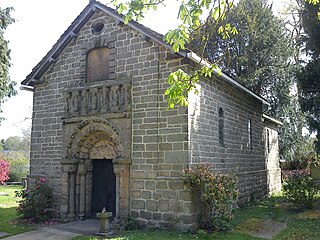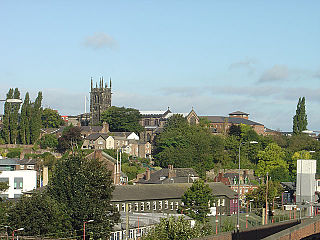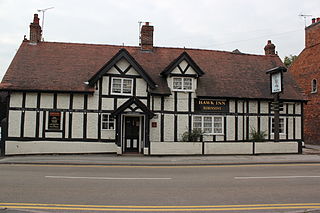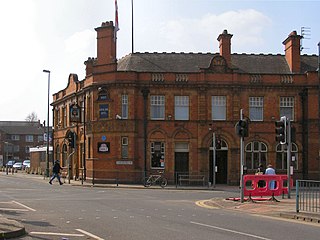
Prestbury is a village and civil parish in Cheshire, England, about 1.5 miles (3 km) north of Macclesfield. At the 2001 census, it had a population of 3,324; it increased slightly to 3,471 at the 2011 census. Alongside fellow "Cheshire Golden Triangle" villages, Wilmslow and Alderley Edge, it is one of the more sought-after places in the north. The ecclesiastical parish is almost the same as the former Prestbury local government ward which consisted of the civil parishes of Prestbury, Adlington and Mottram St Andrew.

Hulme Hall is a house on a moated site in the parish of Allostock, Cheshire, England. It originated in the 15th century, with additions and alterations in the 17th and 19th centuries. It is now a farmhouse. The house is constructed in brown brick, and has a roof of stone-slate and Welsh slate. It is in two storeys with an attic, and has an asymmetrical plan. The northeast front is the entrance front, and has three gabled bays. The garden front is on the northwest; it has five bays, two of which are stepped back in two stages. Most of the windows are two or three-light casements. The house is recorded in the National Heritage List for England as a designated Grade II* listed building. The bridge over the moat leading to the house is also listed at Grade II*. The moated site on which the house stands is a scheduled monument. It had been the home of the Grosvenor and Shakerley families, both of whom were prominent in Cheshire.

Lea Hall is a former country house standing to the northwest of the village of Wimboldsley, Cheshire, England. It dates from the early part of the 18th century, and was built for the Lowndes family. During the 19th century the house was owned by Joseph Verdin. Additions, including dormer windows, were made in the 19th century. During the 20th century the house was divided into three flats. The house is constructed in red brick with ashlar dressings and a tiled roof. It is in two storeys, with an attic and a basement. The roof is large and hipped, with a viewing platform. The entrance front is symmetrical, in five bays, the central bay protruding slightly forward. This bay contains a doorway with a swan's nest pediment decorated with scrolls, and containing a crest with the initials J V. The authors of the Buildings of England series describe the house as a "perfect brick box, delightful if just a little funny to look at". It is recorded in the National Heritage List for England as a designated Grade II* listed building.
Legh Hall stands to the east of the village of Mottram St Andrew, Cheshire, England. It was built in the middle of the 18th century for William Brocklehurst of Macclesfield. The house was built to replace Legh Old Hall. Additions were made in the late 19th century, with alterations in the 20th century. The house is constructed in red brick with yellow headers. It is roofed with Welsh slate. Its architectural style is Georgian. The house is in 2½ storeys, and has a symmetrical five-bay front. It is recorded in the National Heritage List for England as a designated Grade II listed building.
Tytherington Old Hall is a former country house in the Tytherington area of Macclesfield, Cheshire, England. It was built in the late 16th century for the Worth family. The building was much altered during the 20th century, and as of 2010 was in use as an office. Since 2006, it has been renovated and converted to a family home. The house is constructed in timber framing on a stone plinth with stone-flagged roofs. The timber-framing includes close studding and herringbone decoration. It is recorded in the National Heritage List for England as a designated Grade II listed building.

Hurdsfield House is a former country house, now surrounded by housing, in the town of Macclesfield, Cheshire, England. It was built for a branch of the Brocklehurst family. During the 20th century it was used as a welfare clinic. The house dates from about 1800, with later additions and alterations. It is constructed in brick with stone dressings, and has Welsh slate roofs. The house is in three storeys, and its entrance front, facing west, has five bays. In the central bay is a porch with a Doric architrave, over which is a balcony with wrought iron railings. Behind and above this is a tall window with an entablature. The windows are sashes, and at the corners of the house are quoins. The south front originally had three bays, and a further bay has been added to the right. In the angle at the rear of the house is an extension added later in the 19th century. The house is recorded in the National Heritage List for England as a designated Grade II listed building. It has been divided into flats.
The former Governor's House is located in Toft Road, Knutsford, Cheshire, England. It was built for the governor of Knutsford Gaol, and has later been used as a Tourist Information Centre. It was built in 1844 and designed by the Lancaster architect Edmund Sharpe. It is recorded in the National Heritage List for England as a designated Grade II listed building. The house is constructed in red brick in Georgian style. It served as the central offices for the Knutsford Urban District Council, and then for Knutsford Town Council which have been located there since the council formed in 1974.

Macclesfield is a town in Cheshire East, England. It was originally a market town, and was granted a charter in 1261. The medieval town surrounded a hilltop that contained the Church of St Michael and the marketplace. Industry came to the town in the 18th century following the building of the first silk mill by Charles Roe in 1743. This industry grew with the building of more mills, and of houses incorporating weavers' garrets on the top floor, with large windows to light them. The mills were initially supplied with power from horses, or from the River Bollin, which ran through the town. Later, steam power was introduced. Communication was improved by the building of the Macclesfield Canal, which was completed in 1831. The silk industry declined from 1851, industry in the town diversified, and most of the surviving silk mills were converted into other industrial purposes or for domestic use. During the 20th century, some of the buildings were cleared from the town centre, and housing estates were built on the periphery of the town.

The Flying Horse is a Grade II* listed public house at 6 Oxford Street, Marylebone in the City of Westminster. It was built in the 19th century, and is the last remaining pub on Oxford Street. The pub is on the Campaign for Real Ale's National Inventory of Historic Pub Interiors.

The Travellers Rest is a public house at Alpraham, near Tarporley, in Cheshire, England.

The Holly Bush is a public house at 75 Palmerston Street, Bollington, Macclesfield, Cheshire, England. It is recorded in the National Heritage List for England as a designated Grade II listed building.

The Harrington Arms is in Church Lane, Gawsworth, Cheshire, England, and is recorded in the National Heritage List for England as a designated Grade II listed building. It is included in the Campaign for Real Ale's National Inventory of Historic Pub Interiors.

The Hawk Inn is a Grade II listed public house at 137 Crewe Road, Haslington, Cheshire, CW1 5RG.

The Duke of York Inn is a Grade II listed public house at Main Street, Elton, Derbyshire DE4 2BW.

The Three Stags' Heads is a Grade II listed public house in Wardlow Mires, Derbyshire, England.

The Victoria is a Grade II listed public house at St John's Street, Great Harwood, Blackburn, Lancashire BB6 7EP.
The Railway is a Grade II listed public house at 153 Manchester Road, Broadheath, Altrincham, Greater Manchester WA14 5NT.

The Royal Oak is a Grade II listed public house at 34 Barton Lane, Eccles, Salford M30 0EN.

The Plough is a Grade II listed public house at 927 Hyde Road, Gorton, Manchester M18 7FB.















